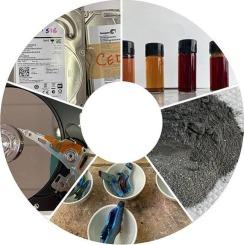电子垃圾磁体中稀土元素的醋酸浸出:工艺优化及动力学评价
IF 7.1
2区 环境科学与生态学
Q1 ENGINEERING, ENVIRONMENTAL
引用次数: 0
摘要
向低碳能源系统的过渡增加了对稀土元素的需求,稀土元素对风力涡轮机和其他可再生能源技术至关重要。然而,稀土资源供应的有限性和地域集中性给能源转型带来了挑战。在这种情况下,电子废物回收,特别是过时的硬盘驱动器(HDD)磁铁,成为减轻供应风险的可持续战略。本研究评价了醋酸作为浸出剂浸出HDD磁体中稀土元素的情况。对来自不同制造商的磁铁的特性分析揭示了化学相似性,从而允许它们进行联合处理和回收。在50°C、3.0 mol−1 CH3COOH、S/L比为1/12的条件下,浸出Nd为18.4 gL−1,Pr为2.9 gL−1,Dy为1.2 gL−1。动力学研究表明,浸出过程是一种混合控制机制,既包括产物层扩散,也包括表面化学反应。这一结论得到了计算活化能和氢泡形成的视觉观察的支持,氢泡的形成可能会阻碍反应物和生成物的扩散,表明多个限速步骤同时影响。这些发现加强了使用有机酸回收稀土元素的可行性,突出了有机酸作为传统浸出方法的可持续替代方案的潜力。本文章由计算机程序翻译,如有差异,请以英文原文为准。

Acetic acid leaching of rare earth elements from e-waste magnets: process optimization and kinetic evaluation
The transition to a low-carbon energy system has increased the demand for rare earth elements (REEs), essential for wind turbines and other renewable energy technologies. However, the limited and geographically concentrated supply of REEs challenges the energy transition. In this context, electronic waste recycling, particularly obsolete hard disk drive (HDD) magnets, emerges as a sustainable strategy to mitigate supply risks. This study evaluated the leaching of REEs from HDD magnets using acetic acid as a lixiviant agent. Characterization of magnets from different manufacturers revealed chemical similarities, allowing their joint processing and recycling. The leaching experiments at 50 °C, 3.0 molL−1 CH3COOH for 2 h, and S/L ratio of 1/12 resulted in 18.4 gL−1 Nd, 2.9 gL−1 Pr, 1.2 gL−1 Dy. The kinetic study indicated that the leaching process follows a mixed-control mechanism involving both diffusion through a product layer and surface chemical reaction. This conclusion was supported by the calculated activation energies and the visual observation of hydrogen bubble formation, which may hinder the diffusion of reactants and products, suggesting the simultaneous influence of multiple rate-limiting steps. These findings reinforce the feasibility of using organic acids for REEs recovery, highlighting their potential as a sustainable alternative to conventional leaching methods.
求助全文
通过发布文献求助,成功后即可免费获取论文全文。
去求助
来源期刊

Waste management
环境科学-工程:环境
CiteScore
15.60
自引率
6.20%
发文量
492
审稿时长
39 days
期刊介绍:
Waste Management is devoted to the presentation and discussion of information on solid wastes,it covers the entire lifecycle of solid. wastes.
Scope:
Addresses solid wastes in both industrialized and economically developing countries
Covers various types of solid wastes, including:
Municipal (e.g., residential, institutional, commercial, light industrial)
Agricultural
Special (e.g., C and D, healthcare, household hazardous wastes, sewage sludge)
 求助内容:
求助内容: 应助结果提醒方式:
应助结果提醒方式:


